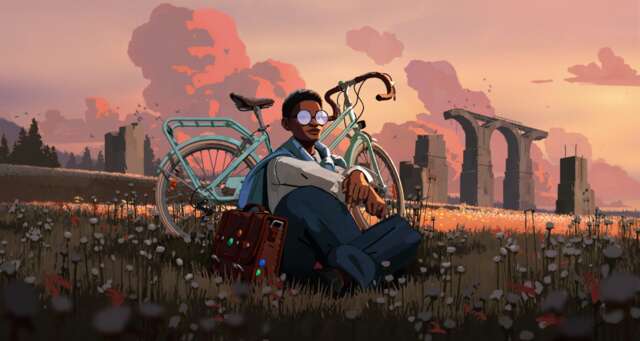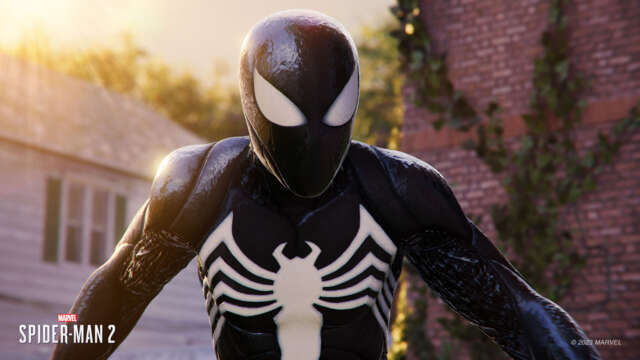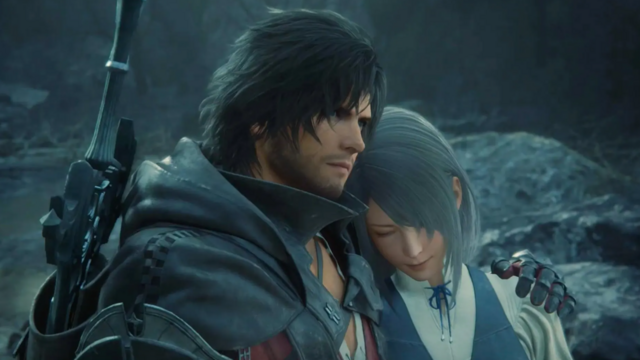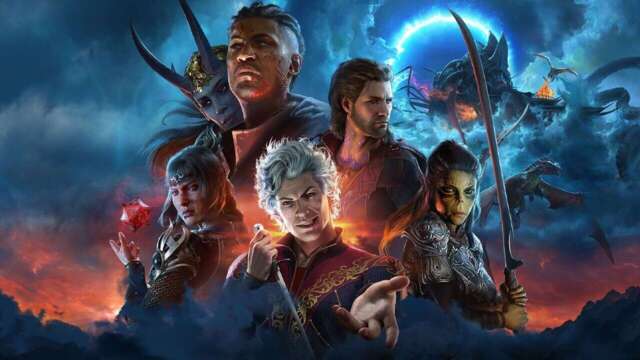|

In looking at the year's best PlayStation 5 games, it shows once again that PlayStation has built a reputation for strong platform exclusives, with a combination of prestige first-party games and third-party offerings from developers like Square Enix. 2023 was no different, offering a wide range of games you can play first, or play best, on a PS5. This is also the year that PS5 came into its own, with many of its biggest games no longer sharing cross-generation releases with the PS4. That means we got to see the power of the new hardware really shine this year like never before. As first-party offerings go, it doesn't get much bigger than the blockbuster action of Spider-Man 2, which as an exclusive takes full advantage of the PlayStation 5 hardware. Similarly, Horizon Forbidden West's PS5-exclusive Burning Shores expansion. Though Forbidden West also received a PS4 version, the PS5 exclusivity of the expansion let developer Guerrilla really spread its shiny metal wings. Third parties rounded out the PlayStation library this year with a number of great games that you can't currently play on any other console . This list does contain a few games available to play on PC as well, and that's a good thing for getting these great games in front of the widest audience possible. But all of these games are console exclusive to PlayStation, making them well worth a look if you have access to the system. (Note: Our picks were made prior to Baldur's Gate 3's surprise release on Xbox Series X|S on December 7.) For more on the best games of 2023, be sure to check out our top 10 games of 2023, along with our Game of the Year winner, Baldur's Gate 3.
Season: A Letter To the Future
Indie games tend to explore spaces deemed too risky for publishers or too niche for some players. Season is nothing if not niche, but it's a good thing it exists. You play as a young woman named Estelle who sets out from her home to document her world on the eve of tremendous change. In her world, "seasons" don't just bring new weather patterns; they are wholly world-altering and usher in essentially new societies, making them more like a (potentially) gentle apocalypse. In gameplay terms, this translates to Estelle biking the countryside with her sketchbook, audio recorder, camera, and freedom to explore the world as you see fit. You'll photograph people as they move to safety and places long or recently abandoned and, through it all, tell your own story by documenting the sights and sounds of a place soon lost to time. As you decide what to immortalize in your sketchbook, you'll create your own narrative, choosing which images, phrases, drawings, and more you feel are crucial to telling the story of the land. It's poetic, soft-spoken, and meditative like nothing else I can recall having experienced. As Estelle cruises down the cliffside on her bike, the wind feels welcoming. As she pauses to rest in a firefly forest, it feels like you, too, are given a chance to just breathe and exist. And then seeing the entire scrapbook in the game's conclusion feels like a trip down memory lane even as you only just arrived there yourself some hours beforehand. Season is as close to a mindfulness practice as one might dream up as a video game, making it a uniquely calming experience. "As Estelle pieces together her scrapbook made by my hand, I often found myself asking why I took a particular image, what I liked about a specific sound," critic Mark Delaney wrote in our Season: A Letter to the Future review. "What memories or feelings was I conjuring, even subconsciously, that led me to present Estelle's world in the ways I did, and what did that say about how I see my own world? Season asks a lot of introspective questions, provides few definitive answers, and hopes players are willing to breathe it in, consider it carefully, then exhale slowly as they reflect on both the game and themselves. It's unconventional even in a sea of indies that are constantly trying new weird things, but it works." -- Mark Delaney
Viewfinder
With the room-by-room structure of Portal, the winking-at-the-camera of The Stanley Parable, and a central mechanic that is wholly its own--and utterly dazzling--Viewfinder is a memorable experiment that makes a heck of a demo, but manages to build on its foundation so that the full game stands up proudly, too. In Viewfinder, you'll place Polaroid-style photos in the world to create new environments and solve platforming puzzles. This invites a ton of creativity, as sometimes more than one solution exists. Do you turn the image of a garden path sideways, then traverse the side of a gazebo like a makeshift bridge, or do you place it in a gap at the right spot to where you can jump across clearings like you're jumping rocks on the beach shore? As that mechanic builds, so too does the art style, including an early section where the developers were clearly showing off: You leave the base world for a pencil-drawn world, then into a watercolor painting, then a vibrant cartoon, straight into a children's photo worthy of a fridge door, then into an early first-person 3D pixelated video game, then finally a black-and-white universe before emerging out the other end. While this earlier section is meant as style, the game proves it has substance, too, with puzzles that will stump and mesmerize in equal measure. "Given how Viewfinder quickly empowers you with the tools to create your own solutions while challenging you to push your understanding of its world, it's pleasantly surprising how frictionless the entire experience is, never once devolving into tedium or frustration," critic Alessandro Barbosa wrote in our Viewfinder review. "Viewfinder finds elegance in simplicity but doesn't trade this for straightforward solutions, making it one of the best puzzle games you can play today." -- Mark Delaney
Marvel's Spider-Man 2
The latest game in Insomniac's highly acclaimed Spider-Man may just be the best yet. The open world has been expanded to include more boroughs of New York City, and the dual Spider-Men--Peter Parker and Miles Morales--have a new gliding wing suit that feels additive to the well-crafted traversal without eliminating the sheer joy of slinging webs around skyscrapers. Manhattan has never looked better, as well, thanks to the PS5's ray tracing that creates beautiful reflective surfaces. Combat has also gotten just enough tinkering to make its best qualities shine, letting you feel like the improvisational hero as you thwip and smack around Kraven's goons. Plus, after a post-credit teaser following the first game, this one delivers a gripping story revolving around the symbiote, Venom. And it sets the table for what looks to be an incredible finale to Insomniac's masterpiece series. Spider-Man 2 is a great showpiece for the PS5 and an expertly-made action spectacle. "All in all, Marvel's Spider-Man 2 may largely give us more of what we've played in Insomniac's previous Spider-Man games, but that winning formula is still so damn fun that it really doesn't matter," critic Jordan Ramée wrote in our Spider-Man 2 review. "The story's exploration of loneliness is fantastic, creating gripping new narratives for the two heroes, Peter and Miles, as well as the two main villains, Kraven and Venom. Spider-Man 2 unites all four characters in a riveting narrative throughline you'll want to see all the way through and has the gameplay hooks to keep you engaged the whole ride." -- Steve Watts
Horizon Forbidden West: Burning Shores
Horizon Forbidden West expanded and iterated on the first game in smart ways, but the sprawling sequel was a lot to take in. For the Burning Shores expansion, we got a smaller, more focused experience. Aloy ventured off to the Burning Shores, the name given to the ruins of Los Angeles, to investigate the disappearance of one more Zenith--the advanced humans who served as the villains and sometimes-allies in the main campaign. There she finds a brewing civil war among the Quen marines who have been marooned there and develops a relationship with one of them, named Seyka. The new setting is gorgeous and shows off the PS5 at its best, and the setting introduces a handful of new machines to collect and pick apart for their precious scrap. But the real standout is the set-piece moments, including the final confrontation, which take the DLC to new heights unmatched even by the main game. It ends on a somber note but establishes an important connection for our heroine that we may see developed further in the future. "Horizon: Burning Shores lays even more groundwork for the future of the franchise than Forbidden West, which had already signaled a clear direction for the next entry," Steve Watts wrote in our Horizon Forbidden West: Burning Shores review. "It does this in a tight, engaging little package that reignited my love for the world and its characters without feeling burdened by it. While much of Burning Shores feels familiar, it's a sweet, condensed experience that captures what makes Horizon games great. After feeling more exhausted than excited at the end of Forbidden West, I'm glad for the reminder." -- Steve Watts
Final Fantasy XVI
The team behind the critically acclaimed MMORPG Final Fantasy XIV took the next mainline entry in the storied franchise in a completely different direction. But even with the shift to character-action gameplay, a la Devil May Cry, with light RPG elements sprinkled in, Final Fantasy XVI remained true to the core ethos of the series. Within a story of warring nations vying for survival and the iconic Eikons at the crux as a parallel to weapons of mass destruction, FFXVI is a story about love, the many forms it can take, and how it becomes a driving force in our lives. It's also brought to you through a cruel medieval world where magic users rise against their oppressors and the powerful reap the seeds they sow in the face of environmental destruction. FFXVI pushed the limits of the PS5's power as an incredible graphical showcase, but it wasn't just for the sake of flexing. The vivid visualizations gave its brutal, yet heartfelt story a certain weight and scale for some of the wildest action set pieces ever displayed in a game before bringing itself back down to earth. And the experience is held together by masterful composer Masayoshi Soken, who weaves all the various threads FFXVI casts out with the sharpest of melodies and harmonies, creating another impressive and memorable entry for Final Fantasy. "Having seen FFXVI all the way through, I'm happy to include it alongside some of my all-time favorites in the series," critic Michael Higham wrote in our Final Fantasy XVI review. "It's heartening to see that this bold approach to both story and gameplay is now part of that legacy, expanding the definition of what a mainline entry could be. It may fall short in some respects, but it should be celebrated for its most stunning moments and the characters who embody them. FFXVI succeeds and earns its place within the Final Fantasy pantheon as one of the great entries, and does so on its own terms." -- Michael Higham
Humanity
Humanity mixes satisfying puzzle-solving with chill flow state vibes to great success. It's easy to compare it to Lemmings, as you're tasked with creating pathways across stages to guide hordes of people toward a goal--in this case, into the light. However, unlike Lemmings, you play as an adorable glowing Shiba Inu, and there's no threat of accidentally killing the humans you're shepherding. If they fall off a ledge, they simply reappear and continue to stumble along the path you've set for them, encouraging experimentation and making for a relaxing, stress-free puzzle experience. Humanity is simple at the beginning but quickly ramps up in complexity as more intricate paths are needed to cross stages and collectables called Goldys are introduced. But where most puzzle games are fine with letting you sit and stew on a level you're stuck on, Humanity offers video hints, preventing frustration while allowing you to continue your journey. The vibes are immaculate in Humanity, with the pulsing beats of its electronic soundtrack and the cool-toned color palette making for a stylish and relaxing game that's befitting of the publisher behind gems like Tetris Effect and Rez. If kicking back and playing on the couch isn't enough, it's also playable in VR. "Humanity is a charming, engaging, and inviting puzzle adventure of a breed that seems all too rare nowadays," Heidi Kemps wrote in our Humanity review. "Its constantly-evolving gameplay, unique premise, and striking audiovisual landscape make for a game that's easy to get sucked into for long periods of time. Even better, when you finish the main game, you can dive into the various user-created levels folks all over the globe are already crafting--or try your own hand at creation. Creation is something humanity excels at, after all." -- Lucy James
Baldur's Gate III
With countless branching storylines, unparalleled freedom, brilliant combat, clever writing, and some of the most compelling (and perfectly voiced) NPCs to ever exist in a video game, Baldur's Gate 3 is truly extraordinary as an immersive single-player RPG. And yet, Larian didn't stop there. Not only is BG3 a fantastic time to play alone, but it's spectacular with friends--and the best way to play with friends has to be on PlayStation 5. Baldur's Gate 3's chaos, humor, and sense of adventure are only amplified when you and your party explore the world of Faerun literally side-by-side. And sure, you can still play online co-op on PC and the game is slated to come to Xbox Series X|S in the coming months, where it will presumably also have split-screen multiplayer, but as of right now this key feature (and the PlayStation 5's gorgeous visuals) give the game a real edge on the Sony console. That said, there are still some real perks to playing BG3 on PlayStation 5 even if you aren't keen on playing with others. Most notably, a lot of love and attention has been given to the PS5 port to ensure that the transition away from PC isn't grating. Radial wheels keep combat and conversation fluid, and the ability to move your character with your thumbstick is (dare I say it) a lot nicer feeling than clicking away at your screen. Plus you can play sitting on your couch, which is also preferred. "Near the end of Baldur's Gate 3, a character says, 'Too much freedom can be frightening.' It's a powerful line within the context of the story, but it also speaks to Baldur's Gate 3 on a deeper level," Jake Dekker wrote in our Baldur's Gate III review. "The freedom that it offers is unprecedented, and it takes a little while to really see the scope of what that means for the game. At times, the sheer number of choices and consequences can be overwhelming. But before long, it becomes apparent that Baldur's Gate 3 allows players to be the authors of their own destinies in a way no other game has before. It's that freedom and reactivity paired with its excellent presentation and fantastic characters that really set Baldur's Gate 3 apart, and it's why after 200 hours I'm still coming back to it. Too much freedom can be frightening, but Larian trusts its players to make the most of it, for better or for worse." --Jessica Howard
|












